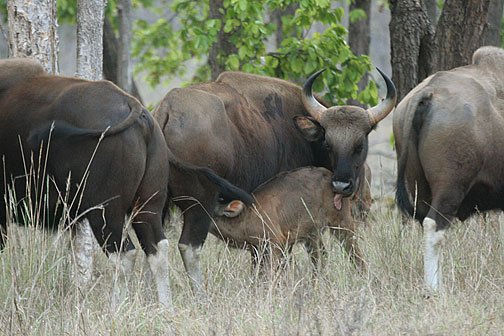Monday 4 July 2011
CITES Species: Indian Bison
The Indian bison (Bos gaurus) or gaur is a large bovine native to South Asia and Southeast Asia. The species is listed as vulnerable on the IUCN Red List since 1986 as the population decline in parts of the species' range is likely to be well over 70% over the last three generations. Population trends are stable in well-protected areas, and are rebuilding in a few areas which had been neglected.
Gaur are said to look like water buffalo at the front and domestic cattle at the back. They are the heaviest and most powerful of all wild cattle, and are among the largest living land animals; only elephants, rhinos and hippos consistently grow larger, and the weight of gaur may equal or even surpass that of a giraffe. Males have highly muscular bodies, with distinctive dorsal ridges and large dewlaps, forming a very powerful appearance. Females are substantially smaller, and their dorsal ridges and dewlaps are less developed. Their dark brown coats are short and dense. There are dewlaps under the chin which extend between the front legs. They have shoulder humps, especially pronounced in adult males.
The gaur has a high convex ridge on the forehead between the horns, which bends forward, causing a deep hollow in the profile of the upper part of the head. There is a prominent ridge on the back. The ears are very large; the tail only just reaches the hocks, and in old bulls the hair becomes very thin on the back. In colour, the adult male gaur is dark brown, approaching black in very old individuals; the upper part of the head, from above the eyes to the nape of the neck, is, however, ashy gray, or occasionally dirty white; the muzzle is pale coloured, and the lower part of the legs are pure white or tan. The cows and young bulls are paler, and in some instances have a rufous tinge, which is most marked in individuals inhabiting dry and open districts.
Horns are found in both sexes, and grow from the sides of the head, curving upwards. They are regularly curved throughout their length, and are bent inward and slightly backward at their tips. The colour of the horns is some shade of pale green or yellow throughout the greater part of their length, but the tips are black. They grow to a length of 32 to 80 centimetres (13 to 31 in). A bulging grey-tan ridge connects the horns on the forehead. The horns are flattened to a greater or less degree from front to back, more especially at their bases, where they present an elliptical cross-section; this characteristic being more strongly marked in the bulls than in the cows.
The tail is shorter than in the typical oxen, reaching only to the hocks. The animals have a distinct ridge running from the shoulders to the middle of the back; the shoulders may be as much as 12 centimetres (5 in) higher than the rump. This ridge is caused by the great length of the spines of the vertebrae of the fore-part of the trunk as compared with those of the loins. The hair is short, fine and glossy, and the hooves are narrow and pointed.
Gaur historically occurred throughout mainland South and Southeast Asia including Vietnam, Cambodia, Laos, China, Thailand, Peninsular Malaysia, Myanmar, Bangladesh, Bhutan, Nepal and India. Today, the species is seriously fragmented within its range, and regionally extinct in Sri Lanka.
They are largely confined to evergreen forests, semi-evergreen, and moist deciduous forest but also occur in dry deciduous forest areas at the periphery of their range. Gaur habitat is characterized by large, relatively undisturbed forest tracts, hilly terrain below an altitude of 5,000 to 6,000 ft (1,500 to 1,800 m), availability of water, and an abundance of forage in the form of grasses including bamboo, shrubs, and trees. Their apparent preference for hilly terrain may be partly due to the earlier conversion of most of the plains and other low lying areas to croplands and pastures. They occur from sea level up to at least 2,800 m (9,200 ft) altitude. Low lying areas seem to comprise optimal habitat.
In Vietnam, several areas in Dak Lak Province were known to contain gaur in 1997. Several herds persist in Cat Tien National Park and in adjacent state forest enterprises. The current status of the gaur population is poorly known; they may be in serious decline.
In Cambodia, gaur declined considerably in the period from the late 1960s to the early 1990s. The most substantial population of the country remained in Mondulkiri Province where up to 1000 individuals may have survived in a forested landscape of over 15,000 km2 (5,800 sq mi). Results of camera trapping carried out in 2009 suggested a globally significant population of gaur in the Mondulkiri Protected Forest and the contiguous Phnomh Prich Wildlife Sanctuary.
In Laos, up to 200 individuals were estimated to occur within protected area boundaries in the mid–1990s. They were reported discontinuously distributed in low numbers. Over-hunting had reduced the population, and survivors occurred mainly in remote sites. Fewer than six National Biodiversity Conservation Areas held more than 50 individuals. Area with populations likely to be nationally important included the Nam Theun catchment and adjoining plateau. Subsequent surveys carried out a decade later using fairly intensive camera trapping did not record any gaur any more, indicating a massive decline of the population.
In China, gaurs occur in heavily fragmented populations in Yunnan and southeast Tibet. By the 1980s, they were extirpated in Lancang County, and the remaining animals were split into two populations, viz. in Xishuangbanna-Yimao and Cangyuan. In the mid-1990s, a population of 600–800 individuals may have lived in Yunnan Province with the majority occurring in Xishuangbanna National Nature Reserve.
In Thailand, gaurs were once found throughout the country, but less than 1,000 individuals were estimated to have remained in the 1990s.
In Bangladesh, a few gaur were thought to occur in the Chittagong Hill Tracts, Sylhet, and Mymensingh areas in the early 1980s. But none had been seen in Pablakhali Wildlife Sanctuary situated in the Hill Tracts since the early 1970s. Individuals from Mizoram and Tripura cross into Bangladesh.
In Bhutan, they apparently persist all over the southern foot-hill zone, notably in Royal Manas National Park, Phipsoo Wildlife Sanctuary and Khaling Wildlife Sanctuary. In Nepal, the gaur population was estimated to be 250–350 in the mid-1990s, with the majority in Chitwan National Park and Parsa Wildlife Reserve. Population trends appeared to be relatively stable. The Chitwan population has increased from 188 to 296 animals in the years 1997 to 2007; a census conducted in Parsa Wildlife Reserve confirmed the presence of 37 gaurs in May 2008. The largest populations are found in India.
Throughout the range, diseases, particularly rinderpest and foot-and-mouth disease, transmitted by domestic cattle are a potentially serious threat. Foot-and-mouth is the most frequent, but rinderpest has had a particularly dramatic impact in India and several sub-populations of Gaur were nearly destroyed as a result of the disease in 1968, while in Bhadra, it nearly wiped out Gaur populations in 1988–1989, when nearly 800 individuals died. In north and central Myanmar anthrax was a major factor in the decline of the species. There is little research or other evidence to determine impacts of introgression with domestic oxen on Gaur populations, although such factors might be expected to be most serious in India, given the wide overlap of domestic stock with Gaur. Farshid Ahrestani saw a Gaur herd of 20 individuals far from human habitation with one domestic ox in the Palni Hills, so it seems likely that introgression occurs to at least some extent.
Srikosamtara and Suteethorn (1995) drew attention to the pressing threats facing Gaur, placing it in the same league of trade-driven threat as better-known species such as Tiger and Asian Elephant, and emphasising the international dimension of trade. Subsequently, the population collapse in Malaysia seems to have been driven by hunting teams from Lao PDR and Thailand (as proven by language at hunting camps in Temenggor), co-opting local Malaysian associates. It is reasonable to expect that when returns in Malaysia drop (as they probably have done already) these teams may turn their attention to other countries’ Gaur populations.Where gaur have not been disturbed, they are basically diurnal. But where populations have been disturbed by human populations, gaur have become largely nocturnal, rarely seen in the open after eight in the morning. During the dry season, herds congregate and remain in small areas, dispersing into the hills with the arrival of the monsoon. While gaur depend on water for drinking, they do not seem to bathe or wallow.
In January and February, gaur live in small herds of 8 to 11 individuals, one of which is a bull. In April or May, more bulls may join the herd for mating, and individual bulls may move from herd to herd, each mating with many cows. In May or June, they leave the herd and may form herds of bulls only or live alone. Herds wander 2–5 kilometres (1.2–3.1 mi) each day. Each herd has a nonexclusive home range, and sometimes herds may join in groups of 50 or more. The average population density is about 0.6 animals per square kilometre (1.5 animals per square mile), with herds having home ranges of around 80 square kilometres (31 sq mi).
Gaur herds are led by an old adult female (the matriarch). Adult males may be solitary. During the peak of the breeding season, unattached males wander widely in search of receptive females. No serious fighting between males has been recorded, with size being the major factor in determining dominance. Males make a mating call of clear, resonant tones which may carry for more than 1.6 kilometres (1.0 mi). Gaur have also been known to make a whistling snort as an alarm call, and a low, cow-like moo.
In some regions in India where human disturbance is minor, the gaur is very timid and shy. When alarmed, gaur crash into the jungle at a surprising speed. However, in Southeast Asia and South India, where they are used to the presence of humans, gaur are said by locals to be very bold and aggressive. They are frequently known to go into fields and graze alongside domestic cattle, sometimes killing them in fights. Gaur bulls may charge unprovoked, especially during summer, when the heat and parasitic insects make them more short-tempered than usual. To warn other members of its herd of approaching danger, the gaur lets out a high whistle for help.
Due to their formidable size and power, gaur have few natural enemies. Leopards and dhole packs occasionally attack unguarded calves or unhealthy animals, but only the tiger and the saltwater crocodile have been reported to kill a full-grown adult. When confronted by a tiger, the adult members of a gaur herd often form a circle surrounding the vulnerable young and calves, shielding them from the big cat. A herd of gaur in Malaysia encircled a calf killed by a tiger and prevented it from approaching the carcass. In Nagarahole National Park, upon sensing a stalking tiger, a herd of gaur walked as a menacing phalanx towards it, forcing the tiger to retreat and abandon the hunt. Gaur are not as aggressive toward humans as wild Asian water buffalos.
There are several cases of tigers being killed by gaur. In one instance, a tiger was repeatedly gored and trampled to death by a gaur during a prolonged battle. A large male tiger carcass was found beside a small broken tree in Nagarahole National Park, being fatally struck against the tree by a large bull gaur a few days earlier.
Source: Wikipedia, CITES, Arkive
Subscribe to:
Post Comments (Atom)







No comments:
Post a Comment
Many thanks for your contribution. Where applicable, we will respond to you here.